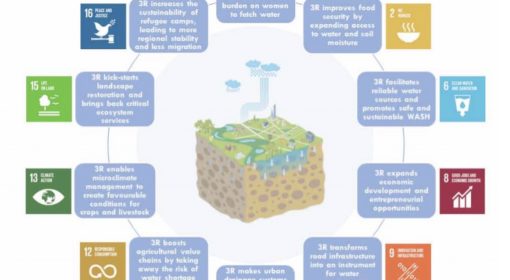posted by Frank van Steenbergen
March 04, 2013

Is this the next revolution in agriculture and water management: plastic mulch?
In rural China, entire landscapes have already been transformed by ultra-thin poly-ethylene plastic foils. They are laid out in long glistening strips, one next to the other. The total area under plastic mulch in China is enormous. One estimate (Kasirajan & Ngouajio, 2012) puts it at 7 million hectares, but this may well be a conservative number. Even then, the plastic mulch coverage in China is five to ten times more than the entire area under drip irrigation in the world. It is twice the total irrigated area of Mexico. Yet amazingly, outside China, plastic mulch is little used.
There are many reasons why more than 80 million Chinese farmers make use of plastic mulch. Not least among its range of uses is the water saving, and the ability to grow crops in dry areas where it would be otherwise impossible.
As there is far less soil evaporation, water saving is considerable. It is usually estimated at 30%. The polyethylene sheet can be used in combination with drip irrigation systems in horticulture, but they work equally well in areas that are traditionally flood irrigated for staple crops. Moreover, where water is collected from a cistern and hand carried this water saving matters a lot.
Another important benefit is that plastic mulch increases soil temperature. Especially in cold areas, this may pre-pone the growing season by three to four weeks. The higher temperature is also good for microbial activity and natural fixation of nitrogen. So less fertilizer is required and less of it is leached to the groundwater – which is good news.
Plastic mulch also suppresses weeds. Here colour matters: white or black plastic blocks out sunlight and avoids the scourge of weeds, whereas agricultural crops are transplanted through opening in the foils. Black varieties help to heat up the soil more effectively.
Further, there are many special uses: one (recently reported in response to another blog) sees plastic mulch covering furrows in corn fields and the soil moisture evaporating against the mulch. The water that then drips back in the furrow and makes it possible for corn seeds to germinate, even in areas that would other wise be too dry for this.
What is more, plastic mulch in China comes cheap. It comes down to USD 25 per hectare for the cheapest quality, and up to USD 160 for better qualities. There are several varieties: different widths, different thicknesses, flexible or brittle. Moreover, it has some resale value as well. In several areas, the mulch that is discarded after one year of use is collected and resold to the suppliers.
So plastic mulch could well be the next farm revolution and the break through for many small farmers, especially in difficult areas: cold, water-scarce or short of basic inputs. The main issue now is the risk of pollution. After being used for a year the torn and damaged poly-ethylene has to be removed. If not, it will screw up the soil and nothing will easily germinate. This removal is time-consuming, but also encouraged as suppliers in China will pay for the used material. In general it is not considered problematic even though some plastic fragments inevitably stay behind, especially of the cheaper mulches.
The bigger solution is to use plastic foil that is fully biodegradable. Biodegradeable mulch has been around for some time, but often the price is still higher than the ‘pure plastic’ varieties. Moreover the earlier biodegradable mulches were not user-friendly. They would become brittle and flaky, and were not easy to use. However a new generation of bio-plastics is in the making, many based on processed starch. If truly bio-degradable, the mulch may on disintegration even add to the soil – nutrients and water. Some fertilizer could even be added to the plastic mulch. If this happens there is nothing that can or should stop the plastic revolution.
Watch related video: On the virtues of plastic mulch in Pinghsun
{jcomments on}
